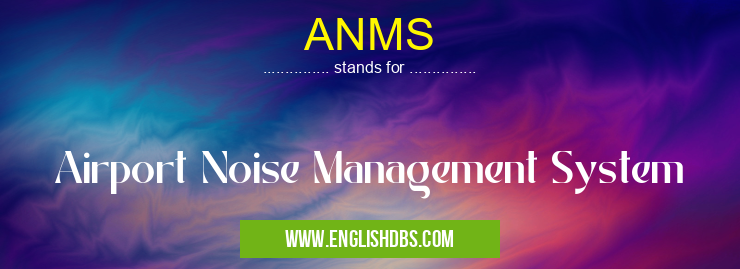What does ANMS mean in AIRCRAFT & AVIATION
ANMS stands for Airport Noise Management System. It is a comprehensive system designed to address the issue of noise pollution around airports. ANMS involves various measures and technologies to monitor, evaluate, and mitigate the impact of aircraft noise on surrounding communities.

ANMS meaning in Aircraft & Aviation in Miscellaneous
ANMS mostly used in an acronym Aircraft & Aviation in Category Miscellaneous that means Airport Noise Management System
Shorthand: ANMS,
Full Form: Airport Noise Management System
For more information of "Airport Noise Management System", see the section below.
Elements of ANMS
-
Noise Monitoring:
- ANMS utilizes noise sensors and monitors to measure and record aircraft noise levels.
- Real-time data is collected and analyzed to identify noise patterns and areas of concern.
-
Noise Modeling:
- ANMS employs noise modeling software to predict future noise levels based on factors such as aircraft type, flight paths, and weather conditions.
- This allows airports to anticipate noise impacts and develop mitigation strategies.
-
Noise Mitigation:
- ANMS includes a range of noise mitigation measures, such as:
- Operational Procedures: Optimizing flight paths and reducing nighttime flights.
- Aircraft Modifications: Installing noise-reducing technologies on aircraft.
- Land Use Planning: Establishing noise restrictions in airport vicinity.
- ANMS includes a range of noise mitigation measures, such as:
-
Community Engagement:
- ANMS emphasizes community engagement and collaboration.
- Airports work with local residents and stakeholders to understand their concerns and develop acceptable noise mitigation solutions.
Essential Questions and Answers on Airport Noise Management System in "MISCELLANEOUS»AIRCRAFT"
What is an Airport Noise Management System (ANMS)?
An ANMS is a comprehensive system designed to proactively manage and mitigate aircraft noise around airports. It encompasses a range of technologies, processes, and regulations aimed at reducing noise impacts on neighboring communities while maintaining efficient airport operations.
What are the key components of an ANMS?
ANMS typically includes components such as noise monitoring systems, noise modeling software, noise abatement procedures, and community engagement programs. These components work together to provide airport operators with real-time noise data, identify noise-sensitive areas, develop noise mitigation strategies, and communicate with affected communities.
How does an ANMS help reduce aircraft noise?
ANMS uses various noise abatement techniques to reduce aircraft noise levels. These techniques may include preferential runway use, flight path adjustments, noise barriers, aircraft noise certification standards, and incentive programs to encourage the use of quieter aircraft.
What are the benefits of implementing an ANMS?
ANMS implementation offers numerous benefits, including:
- Improved community relations by addressing noise concerns
- Enhanced environmental sustainability by reducing noise pollution
- Increased airport capacity by allowing for more efficient flight operations
- Improved health outcomes for noise-affected communities
- Enhanced property values in noise-impacted areas
How does an ANMS promote community engagement?
ANMS incorporates community engagement programs to ensure ongoing dialogue and collaboration between airport operators, residents, and stakeholders. These programs typically involve community noise monitoring, noise complaint response systems, and public consultation forums to gather feedback and address concerns.
Final Words: ANMS plays a crucial role in managing airport noise pollution and improving the quality of life for surrounding communities. By monitoring, evaluating, and mitigating noise impacts, airports can strike a balance between aviation operations and the well-being of neighboring residents.
